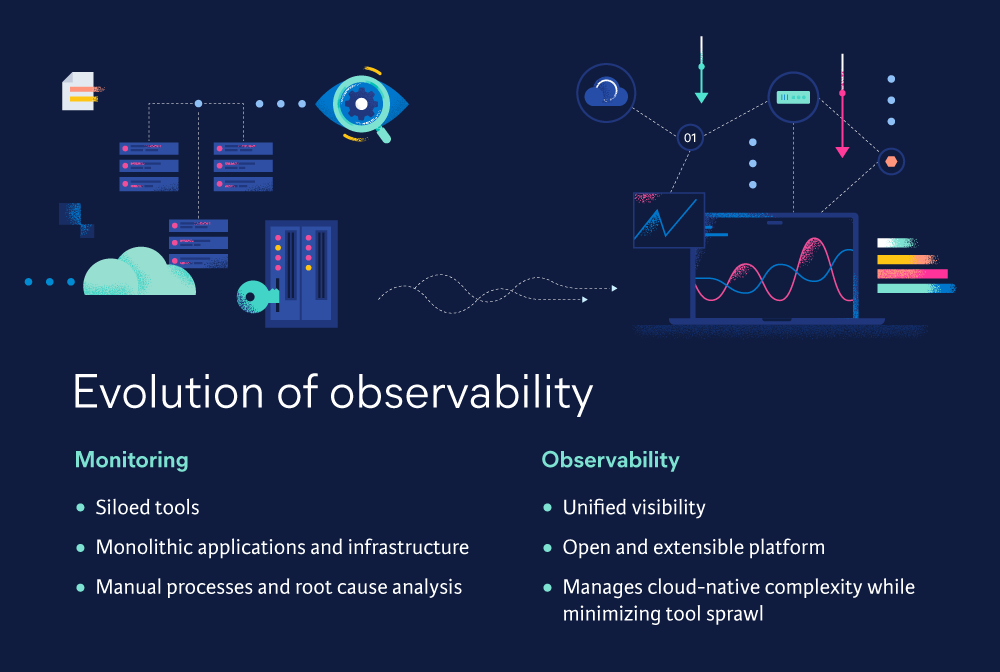3 reasons why monitoring is different from observability

Monitoring and observability are often used interchangeably, but they are not exactly the same. Monitoring is an important part of observability, but observability goes well beyond the scope of traditional monitoring practices.
The key distinction: Monitoring gathers data from individual components — when and what; observability provides insights into the overall behavior of a distributed system — why and how.
The cloud landscape is evolving at a break-neck pace from hybrid cloud computing architectures to serverless technologies and distributed environments. So, while monitoring remains effective for smaller environments (there’s inherently less data and application sprawl), larger organizations using cloud-native technologies need to evolve to more sophisticated tools. That’s where observability comes in. (Say goodbye to FOMO, and read on for the facts.)
What is monitoring?
Monitoring is the process of collecting, ingesting, and analyzing application, infrastructure, and/or cloud telemetry data to assess the health of systems. Monitoring relies on metrics, such as CPU or memory usage and network traffic, logs, and traces. This data enables IT teams to track the performance and availability of their infrastructure and applications in real time. Monitoring tools and platforms can provide dashboards and alerts and have reporting capabilities to help IT teams monitor components, identify predicted issues, and troubleshoot problems that arise in given environments.
However, monitoring tools are traditionally siloed, and therefore, not always suited to modern cloud architectures and larger environments.
What is observability?
Observability is a set of practices and tools that enables IT users to obtain a holistic view of their entire environment through the telemetry and operational data it produces. In distributed systems, observability enables teams to correlate data — logs, metrics, traces, and profiling — to deliver unified visibility. In turn, businesses gain actionable insights to enhance service performance and customer experiences. Observability tools provide customizable dashboards, automation capabilities, analytics, and alerts that help teams perform root cause analysis faster and more effectively.
In other words, observability is an evolving tool for improving the performance and resilience of modern IT operations and the services they manage. After all, better resilience means better productivity — how’s that for ROI?

To better understand modern observability and its value, let’s look at the top three ways it is different from monitoring.
1. Depth of insight
It’s one thing to detect anomalies and inefficiencies; it’s another to understand them.
Monitoring detects: Monitoring relies on predefined sets of metrics and logs to track errors and usage patterns — the known knowns. By this measure, IT teams are limited to discovering issues they’ve already anticipated. In short, monitoring is a necessary IT process that enables teams to ensure everything works as it should. However, though it’s an indispensable detection tool, monitoring does not inherently provide context for detected anomalies.
Observability understands: Observability provides unified visibility by gathering diverse data sources, storing it, and unifying it all for mapping and analysis. This in-depth, correlation capability gives teams a better understanding of their systems overall. They can see and analyze their system behavior, performance, and interactions. Improved visibility and historical performance data also allows a more exploratory approach to operations management to discover unknown unknowns. The depth of insight that IT teams gain also enables them to take a proactive approach to performance.
2. Flexibility and adaptability
Cloud computing and serverless, containerized applications mean increased development flexibility. So, your monitoring solution needs to keep up.
Monitoring can be rigid: Because monitoring relies on sets of data determined by IT teams, it cannot “see” what hasn’t been programmed for it. In other words, monitoring is limited in scope: it tracks known issues but, alone, does not meet the needs of dynamic cloud-native or hybrid environments which often rely on Kubernetes and microservices.
Observability is flexible: Observability, in its ability to map interactions across cloud environments, on-premises software, and third-party applications, is inherently adaptable and flexible. It is a practice designed specifically to meet the needs of modern IT infrastructures. Through automation and AIOps capabilities, observability also scales as ecosystems do, enabling teams to scale their infrastructures more efficiently.
3. Root cause analysis
Issues arise in a tech ecosystem no matter what tools and practices are in place — some things don’t change. When they arise, IT teams can respond in two ways:
Patch the issue — the symptom
Dig in deeper to address the issue — the problem
Root cause analysis done right ensures faster response and recovery times.
Monitoring is reactive: Monitoring alerts are configured to notify teams of anomalies and issues as they occur in real time. While monitoring tells IT specialists “what,” it does not inherently explain “why.” Indeed, in distributed architectures, visibility across data streams is a common challenge. Siloed monitoring tools are limiting: engineers expend additional resources to manually perform root cause analysis while taking a reactive approach to systems management. The result? Slower detection, response, and resolution times, which can mean significant disruptions.
Observability is proactive: Observability facilitates deeper root cause analysis by providing richer context and visibility into internal system operations with historical data. By correlating different data sources and tracing the flow of requests or events through a system, engineers have a holistic view of their environment to pinpoint the underlying causes of problems more accurately. This analysis can be done in real time during an outage, or after the fact, for a proactive understanding of what went wrong. Ultimately, better root cause analysis capabilities mean more efficient operations overall.
Today’s need for modern observability
Moving away from siloed log monitoring tools to a unified data platform and observability is an investment in the future of your organization and to you as an enterprise developer, SRE, or IT operations professional. The evolution from traditional monitoring tools to modern observability is a necessity in today’s cloud-native world. And it prepares teams for future operations enhanced with AIOps and GAI. Modern observability sets an organization on a path to increased efficiency, more resilient applications, and exceptional customer experiences for the business.
Learn more about modern observability:
The release and timing of any features or functionality described in this post remain at Elastic's sole discretion. Any features or functionality not currently available may not be delivered on time or at all.